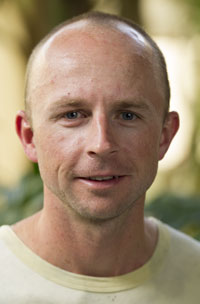Basel, Switzerland
February 3, 2014
 Dr. Bogacki’s area of expertise is molecular plant-microbe interactions. Recently he has been involved in managing fungicide efficacy trials using DNA tests developed by SARDI to quantify levels of plant roots and soilborne pathogens. These quantitative tests can be used to assess the impact of diseases and abiotic stresses on root growth.
Dr. Bogacki’s area of expertise is molecular plant-microbe interactions. Recently he has been involved in managing fungicide efficacy trials using DNA tests developed by SARDI to quantify levels of plant roots and soilborne pathogens. These quantitative tests can be used to assess the impact of diseases and abiotic stresses on root growth.
We spoke with Dr. Bogacki to find out more about his research.
Dr. Bogacki, why is it important to be able to quantify root growth?
Quantifying root growth can give us an indication of plant root architecture and how it is impacted by the various biotic and abiotic stresses that plant roots are exposed to. These stresses can range from soilborne pathogens to subsoil nutrient constraints that can be detrimental to the development of the plant. At SARDI, we have studied root growth to assess the impact of fungicides on Rhizoctonia control, responses of ryegrass to herbicide treatments, and even to screen Australian wheat breeding varieties for genetic variation in root responses to drought.
Can you describe how you study root growth in your lab?
We study root growth by means of quantitative DNA tests developed by SARDI. We believe they offer several advantages over more traditional methods based on biomass and root length measurements, which are time-consuming, prone to error, and not always conducive to plant species with fibrous root systems such as cereals. The quantitative tests are performed on DNA extracted from soil, using a commercial service developed and run by SARDI. The beauty of our extraction method is that we can extract DNA from up to 0.5 kg of soil, which means we can pool many samples to form replicates and considerably reduce processing time compared to other methods. For the quantitative test, we use species-specific TaqMan probes that have been designed using the internal transcribed spacer (or ITS) region of ribosomal DNA. The probes are very specific and sensitive, and we have developed probes to detect a variety of plant roots. The common ones we use are for wheat, but we also have probes for barley and some grasses. Another advantage is that we can use this method together with similar quantitative DNA tests we have developed under the banner of PreDicta B for detecting soilborne pathogens of broadacre crops in Australia.
This quantification method has been applied to assess treatment effects in Rhizoctonia trials. What do results show?
The treatments that we are looking at most closely in wheat and barley involve the liquid application of the fungicide SYNSIF1 in-furrow below the seed and on the furrow surface above the seed. We saw in a 2012 trial that root DNA density was much greater when SYNSIF1 was applied as a split application both in-furrow and on the furrow surface compared with a surface application alone and the untreated control. We looked at root DNA density at 0-5 and 5-10 cm layers of soil and found that the increase was most prominent in the deeper layer. This finding correlated well with a reduction in Rhizoctonia levels from the corresponding samples. We also found that applying the fungicide as a split application was not detrimental to beneficial arbuscular mycorrhizal fungi levels. These trial results suggest that the additional placement of fungicide in-furrow 2-3 cm below the seed is having a beneficial impact on root health.
Why do you think the root density was especially increased in deeper layers and what implication can this have for the plant?
We know from our previous work that Rhizoctonia resides in the top 10 cm of soil and attacks both crown and seminal roots. Hence, we came up with the idea of the split application with the surface band aimed to protect the crown roots and the in-furrow band aimed to protect the seminal roots. The in-furrow application of fungicide had a real beneficial impact in a dry year like 2012. It protected the seminal roots from Rhizoctonia in that vulnerable area and allowed them to grow more. This higher root density meant that the overall health of the root system was probably better and that the treated plants were, therefore, in a much better position to access stored moisture at depth. This should ultimately transfer into higher yielding plants.
Dr. Paul Bogacki was interviewed by Dr. Melanie Goll, Network Community Manager for Syngenta.
Melanie moderates the Global Root Health Network, a group hosted by Syngenta on LinkedIn® professional networking services. This group brings together over 500 leading technical experts from private, public and nonprofit institutions worldwide to exchange knowledge about Root Health and the link to plant performance.
For more information, please contact melanie.goll@syngenta.com or explore the group on LinkedIn at http://www.linkedin.com/groups?gid=3773669.